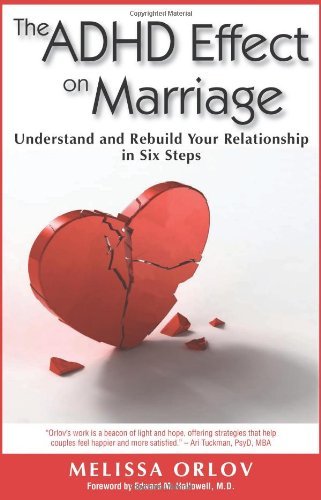Summary/Review of The ADHD Effect on Marriage: Understand and Rebuild Your Relationship in Six Steps by Melissa Orlov (and Edward M. Hallowell)
/By Nicole marino AMFT
Recently, I had the privilege of reading The ADHD Effect on Marriage. I thought the book was well-written and incredibly helpful for marriages consisting of an ADHD and non-ADHD spouse. As a therapist, I found this book enlightening to how ADHD shows up in many relationships, and how it impacts both the ADHD spouse and the non-ADHD spouse. The book was broken down into three main parts: Understanding ADHD in Your Marriage, Rebuilding Your Relationship in Six Steps, and Worksheets/Tools. I am going to go through each part and give a brief summary of what you can expect when reading.
The first part went through the common symptoms of an ADHD diagnosis and how the symptoms present for both the ADHD and non-ADHD spouse. It is important to note that not every relationship has a non-ADHD spouse and an ADHD spouse, but for the purpose of the summary, this is the language and dynamic that was chosen to highlight. This part of the book, from my own experience, allowed me to have a better idea and understanding of what ADHD looks like and how to cultivate empathy for both partners in the relationship who may be suffering. This part went through and explained many statistics and research around ADHD’s impact to a marriage., and the different types of dynamics within a relationship. This part also highlights the rewards of rebuilding a marriage that has been affected by ADHD in a very encouraging, positive, and motivating way. This section goes through symptoms that the non-ADHD spouse may be experiencing and normalizes the impact by including real life examples posted from Melissa Orlov’s interactive blog: adhdmarriage.com.
The next part, and the main part of the book is broken down into six steps to take towards bettering the marriage/relationship. I am not going to fully go through what each section explains but will give a brief overview for reference. To learn more, I highly recommend reading the book to gain more insight, information, understanding, and tools!
1. Cultivating Empathy for Your Spouse: The first step is incredibly important, especially when it comes to healing past resentment. It is key to understand your partner and their experience in the marriage, whether that is the experience of the ADHD spouse or non-ADHD spouse. Being able to empathize with what both partners are going through is a main step towards feeling more connected and on the same page. This also helps when it comes to reactions and responses towards certain triggers or symptoms. Gaining empathy can slow those reactions down to be able to choose a different response to the symptom knowing what the other person is experiencing as well.
2. Addressing Obstacle Emotions: This section better highlights different emotions and responses to symptoms of ADHD specifically from the non-ADHD spouse. For example, anger was a common response to the ADHD struggles in a marriage. The author did a good job including examples to show how anger presents and how it impacts the ADHD spouse most likely on the receiving end of the anger (even though impulsive anger is also another symptom of ADHD). This step discusses how to let go of certain negative emotions/responses as they do nothing productive for the relationship and partner interactions.
3. Getting Treatment for You Both: This step discusses the importance of seeking treatment for both the ADHD spouse and non-ADHD spouse throughout the process of bettering the relationship. For the ADHD spouse, it is helpful to seek professional help to understand symptoms better and gain tools for symptom management. For the non-ADHD spouse, it is important to seek professional treatment to gain support and better coping techniques to manage reactions and emotions towards partner. This step also talks about the choice around medication.
4. Improving Communication: This part walks you through different techniques around having various conversations in a marriage and how it is vital to improve communication in order to improve connection. It is important to listen to one another, validate each other’s experiences, negotiate/compromise respectfully, and increase emotional safety for both partners. This step also goes into how gender plays a role in communication differences, and what to look out for.
5. Setting Boundaries and Finding Your Own Voices: This section goes into personal boundaries, how to identify your own personal boundaries, and how to enforce personal boundaries. The author notes the importance of identifying which boundaries are most important for an individual and where your threshold is for each boundary. With this, you can better understand expectations for each other and what is realistic versus unrealistic to expect. The step then goes into processing how each spouse can respect their partner’s boundaries and create an action plan.
6. Reigniting Romance and Having Some Fun: This step discusses the importance of reintroducing romance and intimacy into your marriage, and how having fun together is a vital part of relationship success. It is important to try and get back to doing fun things together that you use to enjoy at the beginning of the relationship or trying new things together. Having new adventures brings you closer together and reignites that romantic spark and excitement.
The last brief part of the book is a reference chapter full of different tools, techniques, and tips for achieving the six steps. As you read each of the steps, there are different tips and tools specific to what the step’s goal is to help both partners improve on these skills and achieve overall betterment in the marriage/relationship. Not all the tools will be applicable for every person or marriage, depending on the specific struggles you are going through, but you can tailor your toolbox with whatever works best for you and your partner!
Overall, I found this book incredibly beneficial to read not only for my knowledge as a therapist and for my work with my couples/clients, but just to gain a better understanding of how ADHD presents in a person, and a relationship. As someone who has personal relationships with individuals diagnosed with ADHD, I have gained a different perspective on what they may go through every day and how their ADHD shows up for them in their personal relationships. For more information around the book, author, or ADHD in general, you can visit Melissa Orlov’s website at adhdmarriage.com (blog posts included there).




